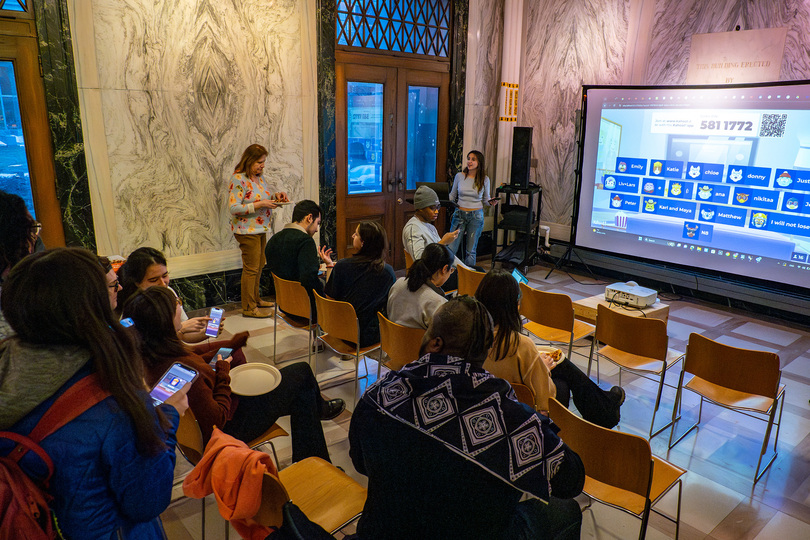SU’s NOMAS chapter ‘builds family’ while emphasizing inclusion

Lars Jendruschewitz | Assistant Photo Editor
The National Organization of Minority Architect Students (NOMAS) hosted a Trivia event as part of their Black History Month celebrations. In collaboration with the King + King Library, the organization gave out books to the winners of the Kahoots.
Get the latest Syracuse news delivered right to your inbox.
Subscribe to our newsletter here.
In Slocum Hall’s Marble Room Wednesday, SU students gathered to answer trivia questions about Black architecture. One question asked the percentage of Black designers in the architecture industry. After a series of guesses, the answer was revealed: they make up 2.8% of the architecture industry, a staggeringly low number compared to most answers.
“It’s really important to me as a minority studying architecture that we have organizations like this so that we’re able to gather together and really connect in ways that aren’t always possible because of the way the field is,” said architecture student and trivia winner Alana Mitchell.
Syracuse University students gathered in Slocum Hall’s Marble Room to learn more about Black architecture through a game of trivia, which aimed to educate students about inequalities in the industry. SU’s King + King Architecture Library joined with the SU chapter of the National Organization of Minority Architect Students (NOMAS) to host the event.
The current vice president of NOMAS, Sterling Fitzgerald, joined the club as an apprentice in his first semester at SU. Over the past year, he has earned a leadership position in the club, allowing him to continue building the organization’s future.
“I’ve been able to see droves of different people and interact with all these great and fascinating people with great ideas that don’t get represented in such a big university,” Fitzgerald said.
Nathan Williams, a professor of Architecture and Design at the Syracuse University School of Architecture, founded a chapter of NOMAS while he was a student in the 1990s at Cornell University. Now, he’s a faculty advisor in the SU chapter of the same organization.
“For me, it’s amazing to see generations and the continuance and the growth of the organization, right here,” Williams said.
NOMAS regularly puts on events celebrating multicultural history in architecture. In the field, there’s very little representation of minorities, given the cost of architecture school and overall environment of the field, Mitchell said. Some students don’t even know the minority professionals who excelled in the field, said Barbara Opar, the architectural librarian at SU.
“I think one of my concerns for students is whether it’s NOMAS or Women in Design that people aren’t aware of their history. They’re in the here and now,” Opar said. “A lot came before that, a lot of people played important roles, which made it easier for the people 20, 30 years later because of these pioneers.”
Ana Karen Ahumada, a sophomore architecture student from Mexico City, Mexico, and an organizer for NOMAS, said the event is a fun change of pace from their typical lecture series, allowing students to kick back and relax after a long studio class.
“It reminds me of home,” Ahmuada said. “I love the club because of that, and I also like that we mix architecture into it. I’m not only celebrating my culture but also gaining architecture knowledge.”
In addition to supporting architecture students at SU, NOMAS works to give back to the community. Their outreach events span from design projects to volunteering alongside JMA Wireless Dome, specifically with the South Side Earth Day Cleanup.
NOMAS has a design competition to redesign a large façade in Syracuse that’s been neglected over the years, TK said. The competition also allows NOMAS members to highlight their skills and prove themselves as architects and community leaders, shedding lights on the organization.
“The biggest thing with having NOMAS is the community. It brings together a lot of great people, especially those who are passionate about the same thing that you are,” Fitzgerald said. “It’s really good to just find that connection, and it builds a family.”
As one of the largest organizations in architecture, the members of NOMAS use the group to uplift each other and highlight the ability of their members, especially at SU, a primarily white institution.
“Black History Month as a whole is very important for educating people. Trivia is just a fun medium to do it through. It brings people together,” Fitzgerald said. “The biggest thing is education.”





